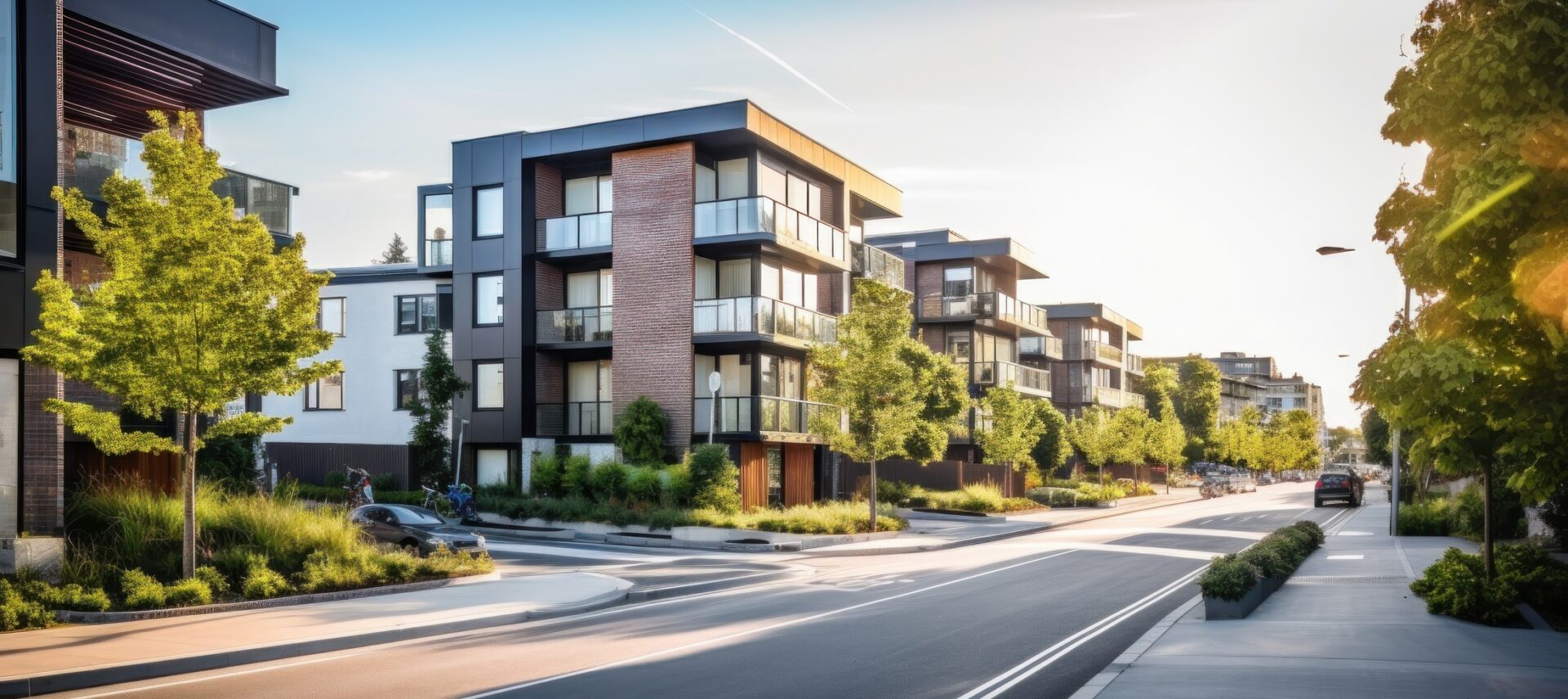News & Insights
The impact of air barriers in meeting new energy codes
This article explores the latest updates in building energy codes, focusing on how air barriers contribute significantly to these new standards.

Air barriers and enhancing airtightness are essential strategies for complying with the more rigorous energy requirements in evolving energy codes. Not only do air barriers ensure that heating and cooling systems don’t have to work as hard to maintain a comfortable indoor environment—thus lowering energy consumption. Modern energy codes and standards, like ASHRAE 90.1 and the International Energy Conservation Code (IECC), explicitly identify and set the performance criteria for the thermal envelope including air barriers.
This article explores the evolving energy codes and shares how architects, engineers, and construction professionals can leverage air barriers to conform with Code requirements and achieve greater energy efficiencies in meeting code.
How building energy codes are evolving
Building codes are regularly updated to incorporate advances in building technology and energy conservation practices, and in recent years there have been major shifts in the code requiring changes in practice by architects, engineers, and construction professionals. These are some of the drivers that are affecting the most recent changes:
- Increased efficiency targets: Newer codes are pushing for higher efficiency levels in buildings to reduce energy consumption and greenhouse gas emissions.
- Focus on whole building performance: Modern codes are moving towards a holistic approach, considering the entire building’s performance rather than just individual components.
- Adaptation to climate change: Building codes are increasingly considering resilience to extreme weather events and climate change impacts.
- Integration of renewable energy: There’s a growing emphasis on incorporating renewable energy sources like solar and wind into building designs.
- Advancements in materials and technology: As technology advances, building codes are adapting to include smart building technologies and more efficient materials and systems.
The two most broadly relevant building codes impacting a building’s energy use are:
- IECC 2021: The International Energy Conservation Code (IECC) is developed by the International Code Council (ICC). The 2021 version of IECC focuses on energy conservation in new and renovated buildings. It includes standards for insulation, windows, lighting, HVAC systems, and other elements that affect a building’s energy consumption. The 2021 update has a significant emphasis on reducing greenhouse gas emissions and encourages the use of renewable energy sources.
- ASHRAE Standard 90.1-2019: This standard is developed by the American Society of Heating, Refrigerating and Air-Conditioning Engineers (ASHRAE). It provides minimum requirements for energy-efficient designs for buildings except for low-rise residential buildings. The 2019 edition includes updates on building envelope, HVAC, power, lighting, and energy cost budget methods. It’s often used as a benchmark for building energy efficiency.
Adapting to the changes is not just about regulatory compliance; it’s about building smarter, more sustainable structures that perform well for the future.
The critical role of air barriers in maximizing energy efficiency
Air barriers have a significant impact in reducing a building’s energy use in addition to meeting new code requirements.
Air barriers have a significant role in the overall performance of the building enclosure by preventing the uncontrolled flow of air in and out of a building. This matters because when air moves unrestricted, it carries heat and moisture, leading to increased energy demands for heating or cooling. By establishing a continuous air barrier, buildings can maintain a more consistent internal temperature, reducing the load on heating and ventilation systems.
The impact of airtightness on a building’s energy consumption is significant. In general, buildings that implement robust air barrier systems can see a reduction in energy use ranging from 10% to 40%. This reduction is more pronounced in regions with extreme weather conditions, where maintaining a stable internal environment is particularly energy intensive.
There are other benefits. Air barriers contribute to indoor air quality, controlling moisture, the longevity of the building materials, and can help with sound isolation. This makes air barriers not only a smart choice for energy efficiency but also for the overall sustainability and durability of the building structure.
Considerations for air barrier design and implementation
There are several key considerations for designing an effective airtight barrier:
- Design for pressure resistance: The building envelope needs to be capable of withstanding both positive and negative pressures. This involves considering factors such as building height, location, and local weather patterns in the design phase so the envelope can handle these pressures without compromise.
- Continuity: The barrier should be continuous over the entire building envelope, without breaks or gaps. This includes ensuring proper seals at joints, transitions, and penetrations with proper detailing in these areas to maintain the integrity of the air barrier.
- Airtight separation of shafts: Shafts like elevators, stairs, and ducts need to be isolated from the floors they connect to manage the movement of air pressure. By using vestibules, gaskets, sealed doors, and panels, the air pressure and quality can be consistent in different parts of the building.
- Integration: The air barrier system needs to be carefully integrated with the building’s other systems, to prevent issues like thermal bridging and moisture accumulation.
- Energy modeling: Air barrier performance can be incorporated into energy models to determine its impact on building energy usage along with other performance strategies.
- Construction quality and workmanship: The success of an air barrier system is highly dependent on skilled installation and adherence to detailed specifications. Because it is a barrier, any failure point can compromise the entire performance.
- Durability: The air barrier system needs to be secure over the expected lifetime of the building.
The role of performance testing in building enclosure design
Modern buildings often have designs with complex geometries, multiple penetrations, and differing materials, making it challenging to create a continuous, unbroken air barrier. In addition, the effectiveness of an air barrier greatly depends on the quality of its installation. It requires skilled labor and strict adherence to specifications. Even small errors or gaps can significantly diminish the barrier’s effectiveness, leading to air leaks.
Construction and functional performance testing provide proof of performance that the air barrier system is effective, and ultimately contributing to the building’s overall energy efficiency and structural integrity. Common tests include:
- Water penetration resistance test: This test evaluates the ability of the building envelope to resist water infiltration by simulating various weather conditions, from light rain to wind-driven rainstorms.
- Air penetration resistance test: This test measures the resistance of the building enclosure to air leakage.
- Whole Building Airtightness Test (WBAT): The WBAT is a comprehensive assessment of the building’s overall airtightness. It involves creating a pressure differential between the inside and outside of the building and measuring the rate at which air leaks through the enclosure. This test detects leaks that might not be apparent in component-specific tests and provides a holistic view of the building’s airtightness.
For the most part, building enclosure systems are non-maintainable components and repairs can typically only be made with the removal of the exterior cladding system. To ensure a performing system, proper design, detailing and ultimately the proper installation of these systems is extremely important. There is one chance to get it right in construction, so it makes sense to verify performance through testing.
How Salas O’Brien can help
Meeting modern energy standards requires not just expertise but also a forward-thinking approach. Salas O’Brien is at the forefront of this, offering tailored solutions in air barrier design, testing, and building commissioning. Our team is adept at navigating the challenges and opportunities presented by new building codes.
Salas O’Brien’s experts partner with you to achieve outstanding results in energy efficiency, building longevity, and indoor environmental quality. We serve you so your project is not just compliant with today’s standards but also meets specific performance needs for your context.
For media inquiries on this article, reach out to Stacy Lake.

Stephen Shanks, CxA, BECxP, NDT Level III
Stephen Shanks is a building scientist and commissioning provider with over 40 years of experience. He possesses a unique blend of expertise in physics and building construction. His knowledge and experience allows him to effectively bridge theory and practice. Stephen is a subject matter expert for Building Enclosure Commissioning (BECx), Air Barriers, Whole Building Airtightness Testing (WBAT), and Thermal-Infrared (IR) Examinations. He is actively engaged in various industry standard and code development committees, including ASHRAE Technical Committees 4.4 Building Envelope Performance and 7.9 Building Commissioning, and ASTM Committee E06 Performance of Buildings. Stephen serves as a Vice President at Salas O’Brien. Contact him at [email protected]